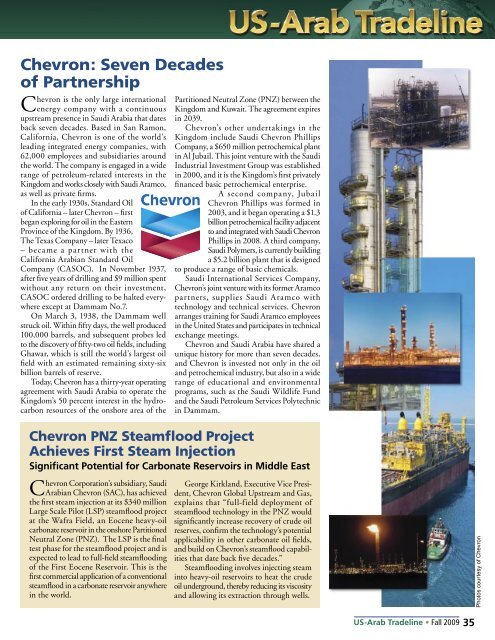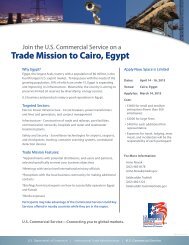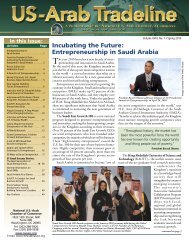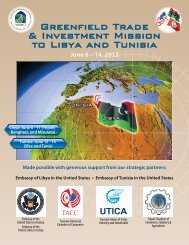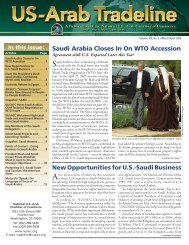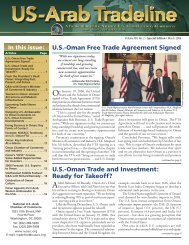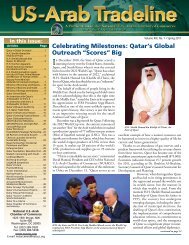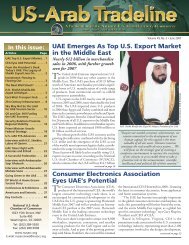Saudi Arabia & KAUST - National US-Arab Chamber of Commerce
Saudi Arabia & KAUST - National US-Arab Chamber of Commerce
Saudi Arabia & KAUST - National US-Arab Chamber of Commerce
You also want an ePaper? Increase the reach of your titles
YUMPU automatically turns print PDFs into web optimized ePapers that Google loves.
Chevron: Seven Decades<br />
<strong>of</strong> Partnership<br />
Chevron is the only large international<br />
energy company with a continuous<br />
upstream presence in <strong>Saudi</strong> <strong><strong>Arab</strong>ia</strong> that dates<br />
back seven decades. Based in San Ramon,<br />
California, Chevron is one <strong>of</strong> the world’s<br />
leading integrated energy companies, with<br />
62,000 employees and subsidiaries around<br />
the world. The company is engaged in a wide<br />
range <strong>of</strong> petroleum-related interests in the<br />
Kingdom and works closely with <strong>Saudi</strong> Aramco,<br />
as well as private firms.<br />
In the early 1930s, Standard Oil<br />
<strong>of</strong> California – later Chevron – first<br />
began exploring for oil in the Eastern<br />
Province <strong>of</strong> the Kingdom. By 1936,<br />
The Texas Company – later Texaco<br />
– became a partner with the<br />
California <strong><strong>Arab</strong>ia</strong>n Standard Oil<br />
Company (CASOC). In November 1937,<br />
after five years <strong>of</strong> drilling and $9 million spent<br />
without any return on their investment,<br />
CASOC ordered drilling to be halted everywhere<br />
except at Dammam No.7.<br />
On March 3, 1938, the Dammam well<br />
struck oil. Within fifty days, the well produced<br />
100,000 barrels, and subsequent probes led<br />
to the discovery <strong>of</strong> fifty-two oil fields, including<br />
Ghawar, which is still the world’s largest oil<br />
field with an estimated remaining sixty-six<br />
billion barrels <strong>of</strong> reserve.<br />
Today, Chevron has a thirty-year operating<br />
agreement with <strong>Saudi</strong> <strong><strong>Arab</strong>ia</strong> to operate the<br />
Kingdom’s 50 percent interest in the hydrocarbon<br />
resources <strong>of</strong> the onshore area <strong>of</strong> the<br />
Partitioned Neutral Zone (PNZ) between the<br />
Kingdom and Kuwait. The agreement expires<br />
in 2039.<br />
Chevron’s other undertakings in the<br />
Kingdom include <strong>Saudi</strong> Chevron Phillips<br />
Company, a $650 million petrochemical plant<br />
in Al Jubail. This joint venture with the <strong>Saudi</strong><br />
Industrial Investment Group was established<br />
in 2000, and it is the Kingdom’s first privately<br />
financed basic petrochemical enterprise.<br />
A second company, Jubail<br />
Chevron Phillips was formed in<br />
2003, and it began operating a $1.3<br />
billion petrochemical facility adjacent<br />
to and integrated with <strong>Saudi</strong> Chevron<br />
Phillips in 2008. A third company,<br />
<strong>Saudi</strong> Polymers, is currently building<br />
a $5.2 billion plant that is designed<br />
to produce a range <strong>of</strong> basic chemicals.<br />
<strong>Saudi</strong> International Services Company,<br />
Chevron’s joint venture with its former Aramco<br />
partners, supplies <strong>Saudi</strong> Aramco with<br />
technology and technical services. Chevron<br />
arranges training for <strong>Saudi</strong> Aramco employees<br />
in the United States and participates in technical<br />
exchange meetings.<br />
Chevron and <strong>Saudi</strong> <strong><strong>Arab</strong>ia</strong> have shared a<br />
unique history for more than seven decades,<br />
and Chevron is invested not only in the oil<br />
and petrochemical industry, but also in a wide<br />
range <strong>of</strong> educational and environmental<br />
programs, such as the <strong>Saudi</strong> Wildlife Fund<br />
and the <strong>Saudi</strong> Petroleum Services Polytechnic<br />
in Dammam.<br />
Chevron PNZ Steamflood Project<br />
Achieves First Steam Injection<br />
Significant Potential for Carbonate Reservoirs in Middle East<br />
Chevron Corporation’s subsidiary, <strong>Saudi</strong><br />
<strong><strong>Arab</strong>ia</strong>n Chevron (SAC), has achieved<br />
the first steam injection at its $340 million<br />
Large Scale Pilot (LSP) steamflood project<br />
at the Wafra Field, an Eocene heavy-oil<br />
carbonate reservoir in the onshore Partitioned<br />
Neutral Zone (PNZ). The LSP is the final<br />
test phase for the steamflood project and is<br />
expected to lead to full-field steamflooding<br />
<strong>of</strong> the First Eocene Reservoir. This is the<br />
first commercial application <strong>of</strong> a conventional<br />
steamflood in a carbonate reservoir anywhere<br />
in the world.<br />
George Kirkland, Executive Vice President,<br />
Chevron Global Upstream and Gas,<br />
explains that “full-field deployment <strong>of</strong><br />
steamflood technology in the PNZ would<br />
significantly increase recovery <strong>of</strong> crude oil<br />
reserves, confirm the technology’s potential<br />
applicability in other carbonate oil fields,<br />
and build on Chevron’s steamflood capabilities<br />
that date back five decades.”<br />
Steamflooding involves injecting steam<br />
into heavy-oil reservoirs to heat the crude<br />
oil underground, thereby reducing its viscosity<br />
and allowing its extraction through wells.<br />
Photos courtesy <strong>of</strong> Chevron<br />
<strong>US</strong>-<strong>Arab</strong> Tradeline • Fall 2009 35


